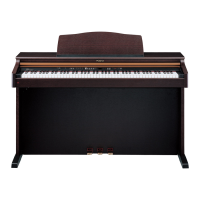Chapter 2. Performance
13
ENGLISH
ENGLISH
ENGLISH ENGLISH ENGLISH ENGLISH
Chapter 2. Performance
Performing with a Variety of
Sounds
The HP103e/102e contains 20 different internal tones. The
tones are organized into five tone groups, which are assigned
to the Tone buttons.
Selecting a tone group
1.
Press any Tone button.
The indicator of the button you pressed will light.
When you play the keyboard, you will hear a sound in the
selected tone group.
Selecting variation tones
2.
Press the [Variation] button.
Four different tones (numbered 1–4) are assigned to each
Tone button. Use the [Variation] button to select among
them.
Each time you press the [Variation] button, the button’s
indicator will change color, and the four sounds will be
selected successively.
Some of the number 3 and 4 tones form pairs, which can be
layered and sounded together.
The tone you’ve selected is heard when you finger the key-
board.
Adjusting the Keyboard
Touch (Key Touch)
You can adjust the touch (playing feel) of the keyboard.
1.
Press the [Key Touch] button.
The button’s indicator will light, and the feel of the key-
board will change.
Each time you press the [Key Touch] button, the button’s
indicator will change color, and the feel of the keyboard
will change.
OFF: Medium. This allows you to play using the most nat-
ural touch. This is the closest to the touch of an acoustic
piano.
Red: Heavy. Fortissimo (ff) cannot be produced unless
you play more strongly than usual, making the keyboard
feel heavier. Dynamic fingering adds even more feeling to
what you play.
Green: Light. Fortissimo (ff) can be produced by playing
less strongly than usual, making the keyboard feel lighter.
This setting makes it easy to play, even for children.
Orange: Fixed. Sounds at a fixed volume, regardless of
your keyboard playing strength.
For more details, refer to
Tone List
(p. 216).
Tone number 1 2 3 4
[Variation] but-
ton’s indicator
Dark Red Green Orange
When Dual play (p. 16) or Split play (p. 17) is used,
only sound number 1 or 2 can be selected.
If you use Dual play or Split play with a Tone button
for which tone number 3 or 4 is selected, tone number
1 will be selected for that Tone button.
1 2
HP103_e.book Page 13 Sunday, September 12, 2004 1:37 PM

